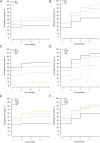Predicting the probability of a live birth after a freeze-all based in vitro fertilization-embryo transfer (IVF-ET) treatment strategy
- PMID: 35800265
- PMCID: PMC9253936
- DOI: 10.21037/tp-21-589
Predicting the probability of a live birth after a freeze-all based in vitro fertilization-embryo transfer (IVF-ET) treatment strategy
Abstract
Background: The predictors for live birth rate (LBR) following one episode of in vitro fertilization (IVF) cycle for patients using a "freeze-all" strategy are not entirely clear.
Methods: A retrospective cohort study utilizing a prediction model was developed to assess the relationship to the LBR. Women undergoing IVF with a freeze-all strategy were screened. Univariate models were first fitted for female age at oocytes retrieval/frozen-thawed embryo transfer (FET), body mass index (BMI), duration and etiology of infertility, previous IVF failures, total dose and duration of gonadotrophin, ovarian sensitivity index (OSI), number of oocytes collected, method of fertilization, number of embryos created, number and stage of embryos frozen, type and number of FET cycles, endometrial thickness (EMT)/pattern, hormone level on transplantation day, storage duration, number of embryos thawed and damaged thawed embryos, number and stage of embryos transferred and number of different quality embryos transferred. Variables with P<0.05 in the univariate model were selected for further analysis of the final multivariate discrete-time logistic regression model.
Results: A total of 7,602 women undergoing one ovarian stimulation resulted in 9,964 FETs, of whom 3,066 (40.33%) had a live-birth after their first FET and 3,929 (51.68%) after total FETs. The EMT and woman's age at oocyte retrieval were the most important predictors. In the first FET, the LBR of women with an EMT ≤8 mm [27.40%; 95% confidence interval (CI): (21.60-33.81%)] was significantly lower than that of women with EMT between 9 and 11 mm [36.51%; 95% CI: (34.25-38.81%)] and thicker than 12 mm [44.23%; 95% CI: (42.22-46.25%)] (P<0.05). The optimistic and conservative cumulative LBRs of women younger than 31 years [87.5%; 95% CI: (86.32-88.61%) and 63.04%; 95% CI: (61.36-64.69%)] were significantly decreased in women aged 31-35, 36-40 and >40 (P<0.001).
Conclusions: Our study provides an effective prediction model for a woman's chance of having a baby after a "freeze-all" policy. The use of EMT and female age as tools to identify LBR are shown to be justified, and repeated FETs cannot reverse the age-dependent decline in fertility.
Keywords: In vitro fertilization (IVF); freeze-all strategy; frozen-thawed embryo transfer (FET); live birth rates (LBRs); prediction model.
2022 Translational Pediatrics. All rights reserved.
Conflict of interest statement
Conflicts of Interest: All authors have completed the ICMJE uniform disclosure form (available at https://tp.amegroups.com/article/view/10.21037/tp-21-589/coif). The authors have no conflicts of interest to declare.
Figures



Similar articles
-
Conventional ovarian stimulation and single embryo transfer for IVF/ICSI. How many oocytes do we need to maximize cumulative live birth rates after utilization of all fresh and frozen embryos?Hum Reprod. 2016 Feb;31(2):370-6. doi: 10.1093/humrep/dev316. Epub 2016 Jan 2. Hum Reprod. 2016. PMID: 26724797
-
Reduced live-birth rates after IVF/ICSI in women with previous unilateral oophorectomy: results of a multicentre cohort study.Hum Reprod. 2018 Feb 1;33(2):238-247. doi: 10.1093/humrep/dex358. Hum Reprod. 2018. PMID: 29211889
-
Factors affecting the outcome of frozen-thawed embryo transfer.Hum Reprod. 2013 Sep;28(9):2425-31. doi: 10.1093/humrep/det251. Epub 2013 Jun 11. Hum Reprod. 2013. PMID: 23756705
-
Higher probability of live-birth in high, but not normal, responders after first frozen-embryo transfer in a freeze-only cycle strategy compared to fresh-embryo transfer: a meta-analysis.Hum Reprod. 2019 Mar 1;34(3):491-505. doi: 10.1093/humrep/dey388. Hum Reprod. 2019. PMID: 30689865
-
Guidelines for the number of embryos to transfer following in vitro fertilization No. 182, September 2006.Int J Gynaecol Obstet. 2008 Aug;102(2):203-16. doi: 10.1016/j.ijgo.2008.01.007. Int J Gynaecol Obstet. 2008. PMID: 18773532 Review.
Cited by
-
Predicting personalized cumulative live birth rate after a complete in vitro fertilization cycle: an analysis of 32,306 treatment cycles in China.Reprod Biol Endocrinol. 2024 Jun 7;22(1):65. doi: 10.1186/s12958-024-01237-3. Reprod Biol Endocrinol. 2024. PMID: 38849798 Free PMC article.
-
Construction of the machine learning-based live birth prediction models for the first in vitro fertilization pregnant women.BMC Pregnancy Childbirth. 2023 Jun 27;23(1):476. doi: 10.1186/s12884-023-05775-3. BMC Pregnancy Childbirth. 2023. PMID: 37370040 Free PMC article.
References
LinkOut - more resources
Full Text Sources
